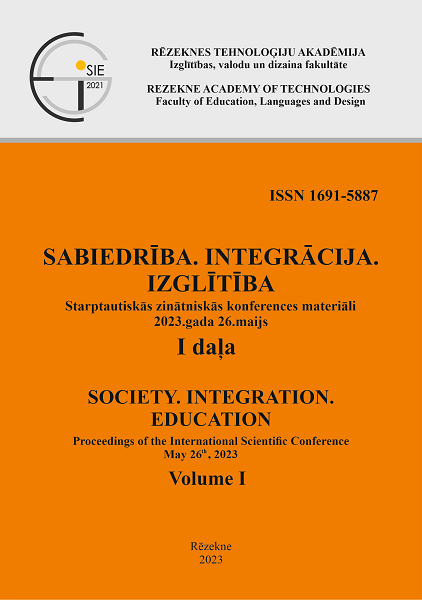RECOGNISING EMOTIONAL ABUSE AND MOBBING IN ADOLESCENTS: CAUSES AND IMPACTS
DOI:
https://doi.org/10.17770/sie2023vol1.7065Keywords:
emotional abuse, emotional well-being, mobbing, students, teachers, parentsAbstract
Emotional abuse can cause severe effects on person`s emotional development, e.g., sense of worthlessness, wearing away confidence and self-esteem, anxiety, depression, etc. Psycho-emotional wellbeing becomes essential for the adolescent to become successful at school, which can be reached through emotional support, understanding and self-discovery. Emotional abuse quite often is not recognized, because of possible judgement from family, friends, teachers and community members. Silence about emotional and physical abuse can be the result of fears and emotional abuse situations which can seem as normal for the victim. Therefore, the first step to solve mental problems is becoming aware of a problem and reducing stigma about mental health. Survey results highlight the need for parents to improve their knowledge, attitudes and skills about emotional abuse and understanding of how to communicate with their children about possible emotional abuse situations at schools. Survey results also highlight that one of the main reasons why mobbing occurs is students` attitude towards difference of others e.g. different interests, lifestyle, appearance, clothes, way of communication, sexual orientation, etc.). Using theoretical and empirical research (survey) methods, the aim of the article is: to describe forms of emotional abuse, highlighting the link between emotional abuse and physical abuse and the impact of it on the emotional well-being of adolescent at school. The authors of the article have identified the main problems faced by students, teachers and parents in cases of emotional abuse.
References
Ancāne, G., Ancāns, A., Miksons, A., & Remese, I. (2014). Ieteikumi izglītības iestāžu psihologiem un pedagogiem darbam ar skolēniem, kuriem ir uzvedības un emocionāli traucējumi skolas. Rīga: Slimību profilakses un kontroles centrs. Retrieved from: https://www.spkc.gov.lv/lv/psihiskas-veselibas-veicinasana/buklets_psihologiem_skolotajiem_uzved_trauc1.pdf
Bozkus, K. (2022). Mobbing, teacher victimization and faculty trust: A structural equation model. International Online Journal of Educational Sciences, 14(1), 77-90. DOI: 10.15345/iojes.2022.01.006
Cohen, L., Manion. L & Morrison. K. (2006). Research Methods in Education. New York: RoutledgeFalmer.
Cornoiu, T. S., & Gyorgy, M. (2013). Mobbing in organizations. Benefits of identifying phenomenon. Social and Behavioral Sciences, 78, 708-712. DOI: 10.1016/j.sbspro.2013.04.380
Doyle, C. (1997). Emotional abuse of children: Issues for intervention. Child Abuse, 6, 330-342. DOI: 10.1002/(SICI)1099-0852(199712)6:5<330::AID-CAR355>3.0.CO;2-C
Elliot-Wright, S. (2016). Overcoming Emotional Abuse. London: Sheldon Press.
Evans, P. (2010). The Verbally Abusive Relationship: How to Recognize it and How to Respond. Avon: Adams Media Corporation.
Freyd, J., & Goldsmith, R. (2005). Effects of Emotional Abuse in Family and Work Environments Awareness for Emotional Abuse. Journal of Emotional Abuse, 5(1), 95-123. DOI: 10.1300/J135v5n01_04
Garbarino, J., & Garbarino, A. (1994). Emotional Maltreatment of Children. Chicago: National Committee to Prevent Child Abuse.
Jantz, G.L., & McMurray, A. (2013). Hope and Healing from Emotional Abuse. Ada: Baker publishing group.
Josipovic-Jelic, Z., Stoini, E., & Celic-Bunikie, A. (2005). The effect of mobbing on medical staff performance. Acta Clinica Croatica, 44(4), 347-352.
Leymann, H. (1990). Mobbing and psychological terror at workplaces. Violence and Victims, 5(2), 119-126.
Lipinski, B. (2001). Heed the Call: Psychological Perspectives on Child Abuse. Los Angeles: Sojourner Press.
Lorenz, K. (1963). On Aggression. San Diego: Harcourt Brace.
Martinsone, K., Pipere, A., & Kamerāde, D. (2016). Pētniecība: teorija un prakse. Rīga: RaKa.
Maslach, C. (2003). Job burnout: New directions in research and intervention. Current Directions in Psychological Science, 12(5), 189-192. DOI: http://dx.doi.org/10.1111/1467-8721.01258
Mathews, A. (2016). When is it Emotional Abuse? Retrieved from: https://www.psychologytoday.com/us/blog/traversing-the-inner-terrain/201609/when-is-it-emotional-abuse
National Institute for Health and care excellence. (2017). Child abuse and neglect guideline. Retrieved from: https://www.nice.org.uk/guidance/ng76
Slimību profilakses un kontroles centrs. (2017). Psihiskā veselība Latvijā 2016.gadā. Tematiskais ziņojums. Rīga: Slimību profilakses un kontroles centrs.
Tough, P. (2012). How Children Succeed: Grit, Curiosity, and the Hidden Power of Character. New York: Barnes and Noble.
UNICEF. (2021). The State of the World's Children 2021: On my mind Promoting, protecting and caring for children’s mental health. Retrieved from: https://www.unicef.org/lac/en/reports/state-of-the-worlds-children-2021-on-my-mind
United Nations. (1989). The Convention on the Rights of the Child. Retrieved from https://www.ohchr.org/en/instruments-mechanisms/instruments/convention-rights-child
World Health Organization. (2017). World Health Statistics 2017. Retrieved from https://apps.who.int/iris/bitstream/handle/10665/255336/9789241565486-eng.pdf;jsessionid=B3A70C41AE6D73D9FFE68E5F7B4CE5A9?sequence=1






